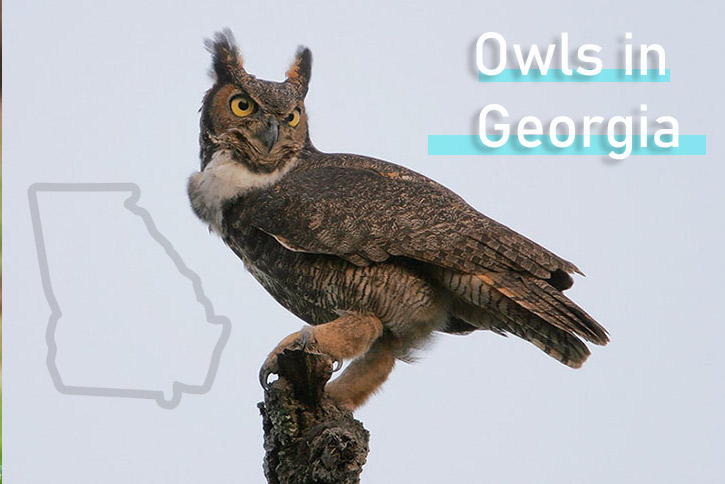
Georgia has lots of beautiful birds, owls included! Most owl species in Georgia might hide during the day but, with some luck and effort, several can be seen.
Which owls live in Georgia? Which owls of Georgia can you see in your backyard? See this article to learn about and identify the owls of Georgia!
On this page
Owls in Georgia
Based on sightings in eBird, we made a list of five common owl species in Georgia that are regularly seen. Since four additional rare species also visit the state during the winter months, we included those birds too. Who knows, maybe you will find one of those rare owls!
To help learn about and identify the owls of Georgia, we have included information about their behavior and identification. The owls are arranged from the most common to the least common.
Barred Owl
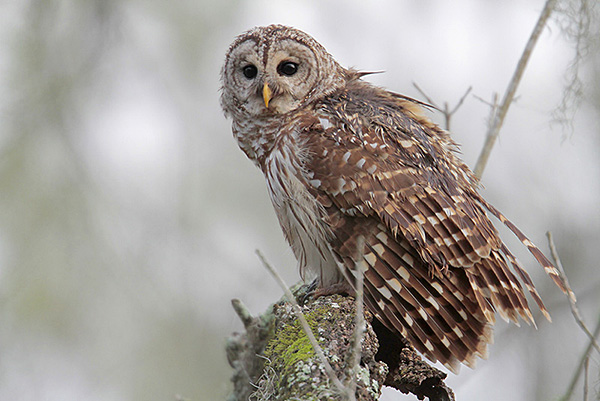
Photograph © Greg Lavaty.
- Range: A permanent resident in most forested areas in Canada, parts of some Pacific Northwestern states, and most of the eastern USA.
- Length: 21 inches
- Wingspan: 42 inches
- Call: Makes loud hooting and caterwalling sounds, “Who cooks for you?! Who cooks for youaaaal!”
The Barred Owl is a medium to large owl with a round head and a narrow black border on its pale gray face. It has dark brown upperparts with white markings, and dark brown streaks on its belly.
This species also has a yellowish beak and dark eyes. Both sexes look the same except that females are a bit larger than males.
The Barred Owl flaps and glides on big, broad wings. It also has a medium-length, broad tail with a few dark brown bands.
Key Identifications:
- Big owl with a round head that has white marks on dark brown upperparts, and dark brown streaks on pale underparts.
- Perches and swoops through wooded areas at night but can also be active in the day.
- Nests in tree cavities and in abandoned nests of crows and hawks.
- Catches a wide variety of small animals.
The Barred Owl lives in deciduous and coniferous forest and woodlands. It nests in the abandoned nests of raptors and crows, and in tree cavities. Barred Owls are recognized by their round head and dark streaks on pale underparts. Male and female Barred Owls make bizarre, loud laughing sounds when they call together.
Great Horned Owl
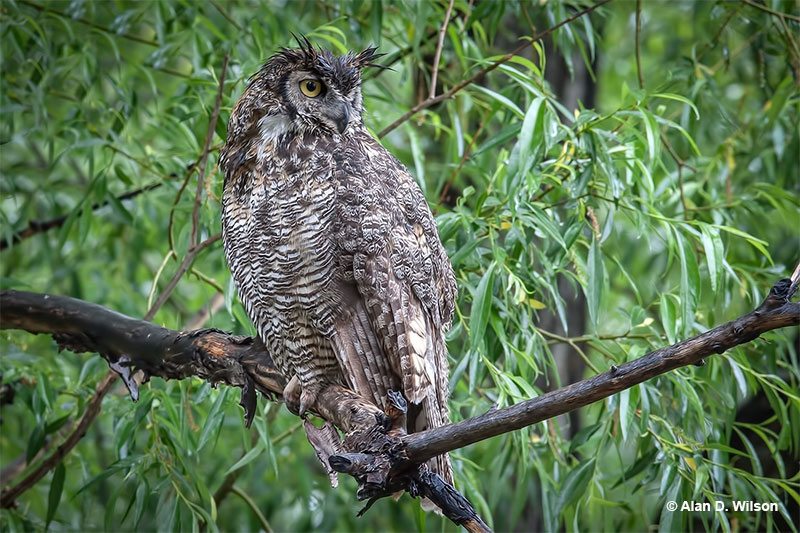
- Range: Permanent resident in much of Alaska, Canada, and the USA.
- Length: 22 inches
- Wingspan: 44 inches
- Call: Makes a low, gruff, “hooo, hoo hoo hoo hoooo”.
The Great Horned Owl is a big, bulky owl with big ear tufts and a black beak. It is mottled gray and brown, has a rufous or gray face, and fine black barring on its underparts. This owl also has a white throat and some dark marks on its breast.
Males and female Great Horned Owls look the same but females are larger. They also have a medium-length tail with dark bands, and long, broad wings.
This nocturnal owl species lives in every possible habitat, including urban areas.
Key Identifications:
- Big, bulky brown or gray owl with ear tufts and fine barring on its underparts.
- Nests in old stick nests of other large birds, on ledges, and in other situations.
- Watches from a perch or glides over open habitats at night, to catch mammals and some birds on the ground.
The Great Horned Owl lives in every type of habitat in much of North America, including Georgia. It nests in old stick nests of hawks and other birds, or on ledges, and other situations. Great Horned Owls are easily recognized by their big, bulky size, ear tufts, and finely barred underparts. The talons and grip of this species are so strong, once closed, 28 pounds of pressure are needed to open them!
Eastern Screech-Owl
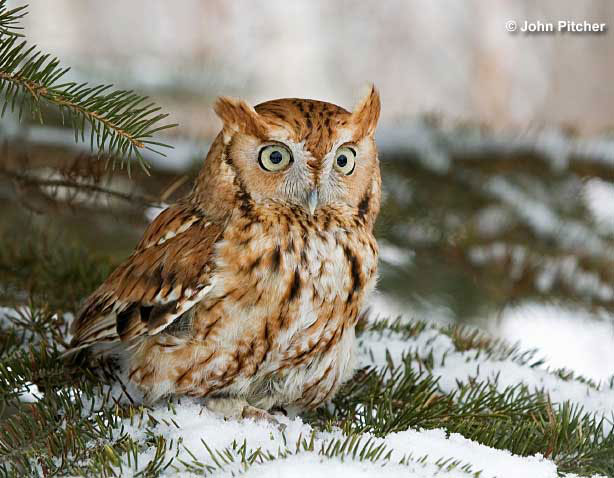
- Range: Permanent resident in parts of southeastern Canada, and in much of the eastern USA.
- Length: 8.5 inches
- Wingspan: 20 inches
- Call: Makes a rather high-pitched, descending whinny call, and a tremulous, vibrating call on the same pitch, “wududududududududududu”.
The Eastern Screech Owl is a small owl with ear tufts. It can be reddish, brown, or mostly gray, has “V”-shaped pale eyebrows, and some black on the edge of its face. It is also mottled above with some white spotting, and has pale underparts with dark barring and streaks.
Males and females look alike but females are a bit larger. This species also has yellow eyes, a pale yellow-gray beak, and some white bands on its broad tail.
Eastern Screech-Owls flap and glide on long, broad wings.
During the day, this owl hides in holes, or in dense vegetation. Eastern Screech Owls are common owls of Georgia.
Key Identifications:
- Small owl with ear tufts and mottled brown or gray plumage that lives east of the Rocky Mountains.
- Lives in a variety of wooded and park-like habitats.
- Nests in tree cavities and nest boxes.
- Swoops down to the ground catch a variety of small animals at night.
The Eastern Screech-Owl lives in wooded and park-like habitats east of the Rocky Mountains in Canada and the USA. Eastern Screech-Owls are identified by their ear tufts, small size, range, and voice. This species is more common than most people realize and often lives in urban situations. Put up a nest box in the backyard and one might move in!
Barn Owl
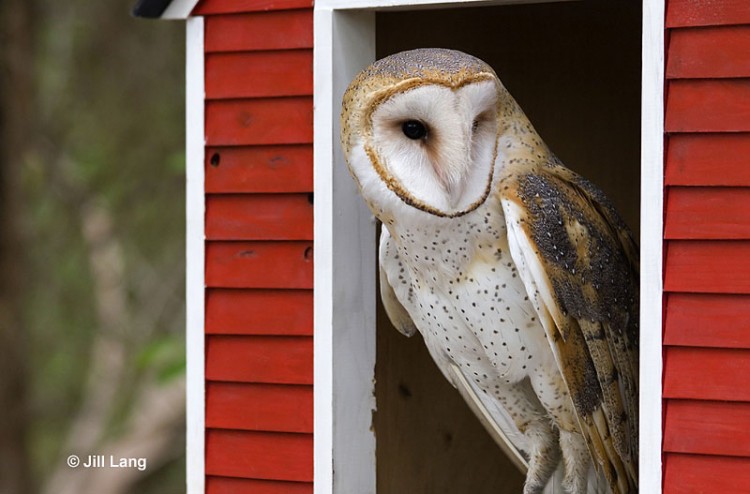
- Range: In Canada, occurs mostly in southwestern British Columbia. In the USA, they live in many areas but are absent from mountains and cold, northern regions. They range north to Washington, Nebraska, Iowa, and New York.
- Length: 16 inches
- Wingspan: 42 inches
- Call: A shrill, loud, hissing “shriiiiii!”
The Barn Owl is a medium to large, pale owl with golden tan and gray upperparts, and white underparts. It has a distinctive, white, heart-shaped face.
Both sexes are alike but females are a bit larger than males and have buff on their chest.
In flight, Barn Owls look like a large, pale, moth-like bird with a big, rounded head.
This owl hunts in grasslands, farms, and other open habitats.
Key Identifications:
- Large pale owl with a heart-shaped face.
- Glides and flutters over fields and other open areas at night.
- Nests in tree cavities, crevices in church steeples and other structures, and next boxes.
- Preys on rats and other small animals.
The Barn Owl lives in many urban and open habitats in regions with mild or no winters. It nests in church steeples, barns, tree cavities, and other similar situations. They are common owls in Georgia. This species is easily recognized by its white, heart-shaped face, and unstreaked, pale plumage. Barn Owls have incredible hearing that helps them catch prey in total darkness.
Burrowing Owl
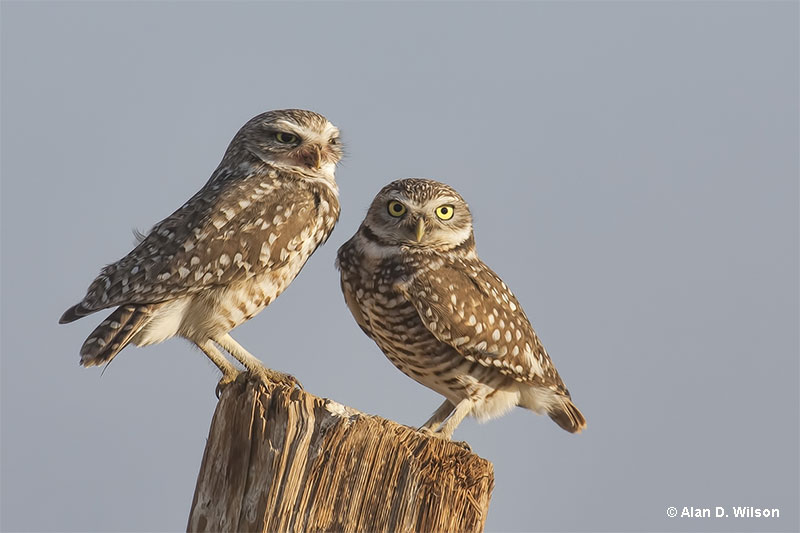
© Alan D. Wilson
- Range: Summer resident in central-southern Canada, the Great Plains, and much of the western USA. Permanent resident in California, Texas, and Florida.
- Length: 9.5 inches
- Wingspan: 21 inches
- Call: Makes a raspy, chattering call, “rap, rip,rip,rip,rip”, and a quail-like, “whup waaah!”.
The Burrowing Owl is a small, long-legged owl with a white throat and white eyebrows. It has a round head, is dark brown with white spots above, and has pale underparts with dark barring.
Males and females look alike, although females are a bit larger. Young birds are uniform dark brown and buff.
Adult Burrowing Owls in Florida are more heavily marked below than western birds but juveniles from Florida are paler.
The Burrowing Owl is active day and night in grasslands, deserts, and other open habitats. Burrowing Owls are one of the most common owl species in Georgia.
Key Identifications:
- Small, long-legged owl with a round head, and some brown barring on pale underparts.
- Lives in grasslands and other wide-open habitats.
- Nests in burrows made by prairie dogs and other animals although birds in Florida make their own burrows.
- Catch small animals on the ground at any time of the day or night.
The Burrowing Owl occurs in open habitats in south-central Canada, the western USA, and Florida. It nests in burrows. Burrowing Owls are easily identified by their small size, round head, barred underparts, and terrestrial behavior. Like some other animals that live in burrows, this species is more tolerant of carbon dioxide than other birds.
Rare Owls in Georgia
Short-eared Owl
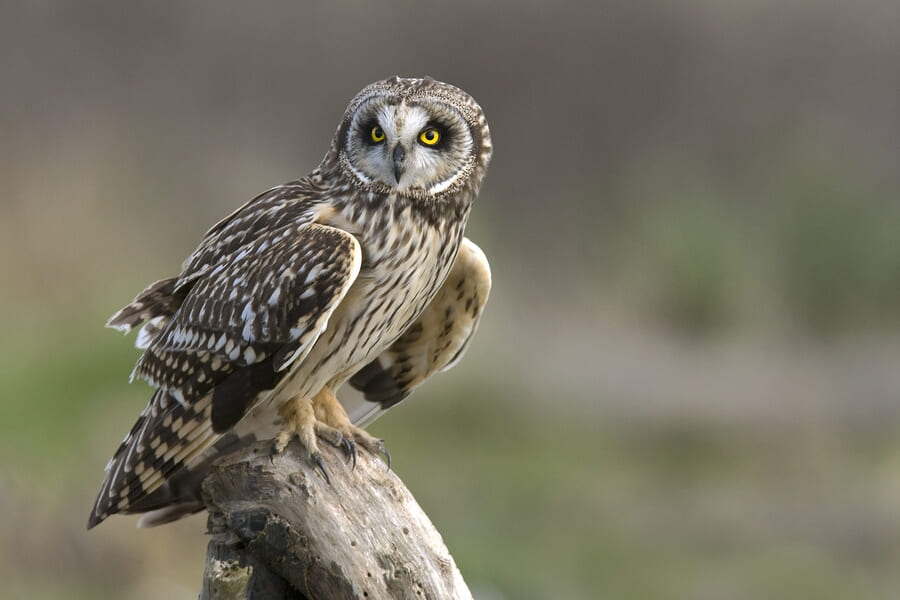
- Range: Summer resident in Alaska, Canada, and the western and central USA. Northern birds migrate to the USA, south to California and Texas.
- Length: 15 inches
- Wingspan: 38 inches
- Call: Makes a hoarse, raspy, cat-like call, “rehw”.
The Short-eared Owl is a medium-sized, pale brown owl with dark eye patches on a pale face. They have a dark breast and streaks on pale underparts. This species has long wings with buff wing patches.
Both sexes look similar but females are a bit larger and usually darker and buffier.
This owl is active day and night in open fields.
Key Identifications:
- Medium-sized pale brown and buffy owl with very short ear tufts.
- Dark eye patches on a pale face and long wings with buff patches near the wingtips.
- Nests on the ground in dense vegetation.
- Glides over open fields to catch small animals on the ground.
The Short-eared Owl lives in open habitats in Alaska, Canada, and much of the USA. Short-eared Owls can be spotted in Georgia. It nests on the ground in dense vegetation. This species is identified by its dark eye patches on a pale face, and long wings with buff patches near the wingtips. On account of their long migrations, Short-eared Owl have become established on Hawaii, and the Galapagos Islands.
Northern Saw-whet Owl
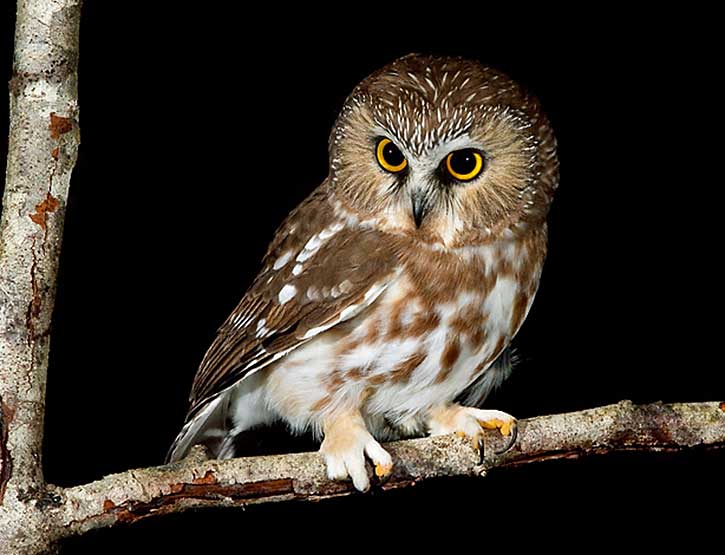
- Range: Lives in coniferous and mixed hardwood forests of Alaska, a large area of Canada, and parts of the northern and western USA.
- Length: 8 inches
- Wingspan: 17 inches
- Call: Makes a repeated tooting whistle call, over and over, “tu, tu, tu, tu, tu, tu, tu, tu, tu”.
The Northern Saw-whet Owl is a small, dark brown owl with a round head and brown streaks on white underparts. It also has some pale streaks on its head, a brown and white face, and some white spotting on its back.
Both sexes look the same but females are a bit larger. This species also has yellow eyes, a dark beak, longish, rounded wings, and a short, broad tail.
This nocturnal owl lives in forested habitats.
Key Identifications:
- Small, dark brown owl with a round head, broad white eyebrows, and thick dark streaks on pale underparts.
- Occurs in dense coniferous and mixed forest.
- Nests in old woodpecker holes and can use nest boxes.
- Swoops down to catch insects and small animals at night.
The Northern Saw-whet Owl breeds in coniferous and mixed forest in Canada and the northern and western USA. It nests in old woodpecker holes and is identified by its small size, round head, thick white eyebrows, and thick streaks on pale underparts. The name of this owl refers to the similarity of its call to the sound made by sharpening an antique old saw blade.
Snowy Owl
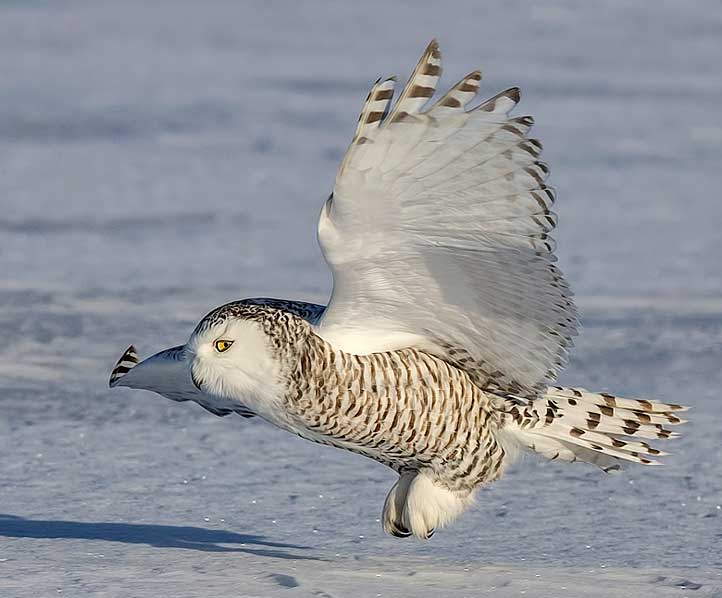
- Range: Summer resident in northern Alaska and northern Canada. It winters in Canada and the northern USA.
- Length: 23 inches
- Wingspan: 52 inches
- Call: Usually quiet but occasionally makes a low, gruff call, “whew…whuh”.
The Snowy Owl is a big, mostly white owl with a round head and yellow eyes. Some males are mostly white but most have some small dark marks. Females and young birds have white faces and varying degrees of black barring.
Females are a bit larger than males and have more black markings than males. Snowy Owls also have long, broad wings and a broad tail.
This owl species is active during the day and lives in wide-open habitats.
Key Identifications:
- Big white owl with a round head, and varying degrees of black or dark gray barring and spots.
- Lives in tundra and winters in wide open habitats.
- Nests on the ground, on elevated spots in Arctic tundra.
- Watches from a perch and glides low to catch small animals on the ground.
The Snowy Owl lives in Arctic habitats but also winters in open areas in Alaska, Canada, and the northern USA. It nests on elevated spots on the ground in the Arctic tundra. This species is unmistakable; it is the only big, mostly white owl. The wide open terrain at airports are ideal for this species and are some of the best spots to see a Snowy Owl.
Long-eared Owl
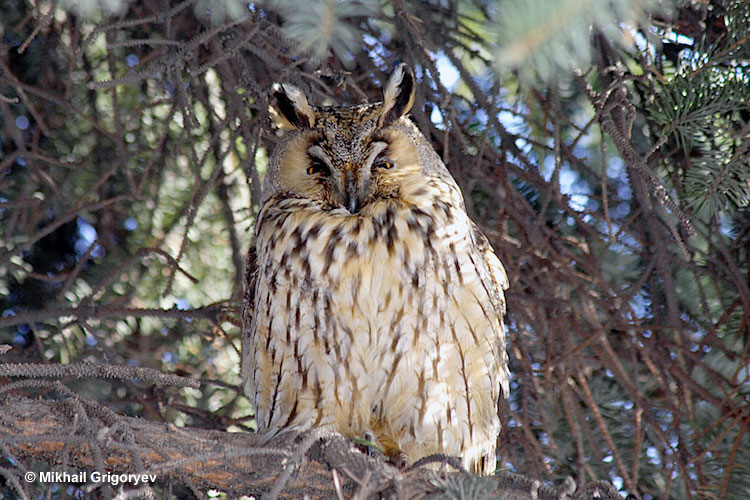
- Range: Migrant in southern Canada, resident and winters in much of the USA. Absent from parts of the Pacific Northwest and southeastern states.
- Length: 15 inches
- Wingspan: 36 inches
- Call: Makes a single, one second long “Hooo!” call at regular intervals.
The Long-eared Owl is a medium-sized, slender owl with long ear tufts. It has an orange face, is mottled gray above, and has dark brown streaks and marks on pale underparts. This owl also has long wings with a rufous patch in its primaries.
Male and female Long-eared Owls look similar but females are larger. This owl species also has yellow eyes, and some pale markings between its eyes and around its dark beak.
This nocturnal owl frequents coniferous woodlands near meadows.
Key Identifications:
- Medium-sized, slender owl species with long ear tufts, orange on its face, and long wings with an orange-brown patch near the wingtips.
- Occurs in coniferous and mixed forests near meadows, bogs, and other open areas.
- Nests in old crow, magpie, and hawk nests.
- Glides over open habitats near forest at night to catch small animals on the ground.
The Long-eared Owl occurs in forest with open areas in Canada and much of the lower 48 states. This owl nests in old magpie, crow, and hawk nests. Long-eared Owls can be recognized by their long ear tufts, orange face, slender appearance, and long wings with orange-brown patches near the wingtips. Wintering roosts of Long-eared Owls in Serbia can host thousands of birds!
Owls in Georgia – Frequently Asked Questions
Are there owls in Georgia?
Yes, there are owls in Georgia. Five species are commonly heard and seen, and four other owl species are rare winter visitors.
Why are there so few owls in Georgia?
There may seem to be few owls in Georgia because most are nocturnal and hide during the day. There are actually five common owl species in Georgia that are regularly heard and seen.
Are owls endangered in Georgia?
No owls are endangered in Georgia.

